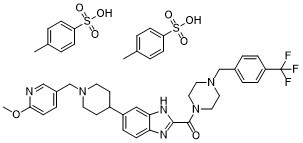ASP4132 tosylate (ASP-4132) is an oral bioavailable AMPK activator (EC50 = 18 nM) with potential anticancer activity. Upon oral administration, ASP4132 affects oxidative phosphorylation in mitochondria of metabolically-active tumor cells, which reduces both energy production and tumor cell proliferation. Mitochondrial oxidative phosphorylation is hyperactivated in tumor cells and plays a key role in the promotion of tumor cell proliferation.
Physicochemical Properties
| Molecular Formula | C46H51F3N6O8S2 |
| Molecular Weight | 937.0578 |
| Exact Mass | 936.316 |
| Elemental Analysis | C, 58.96; H, 5.49; F, 6.08; N, 8.97; O, 13.66; S, 6.84 |
| CAS # | 1640294-30-9 |
| Related CAS # | 1640294-29-6;1640294-30-9; |
| PubChem CID | 146673134 |
| Appearance | White to off-white solid powder |
| Hydrogen Bond Donor Count | 3 |
| Hydrogen Bond Acceptor Count | 15 |
| Rotatable Bond Count | 9 |
| Heavy Atom Count | 65 |
| Complexity | 1110 |
| Defined Atom Stereocenter Count | 0 |
| InChi Key | KDMGCEXVMOJAAC-UHFFFAOYSA-N |
| InChi Code | InChI=1S/C32H35F3N6O2.2C7H8O3S/c1-43-29-9-4-23(19-36-29)21-39-12-10-24(11-13-39)25-5-8-27-28(18-25)38-30(37-27)31(42)41-16-14-40(15-17-41)20-22-2-6-26(7-3-22)32(33,34)352*1-6-2-4-7(5-3-6)11(8,9)10/h2-9,18-19,24H,10-17,20-21H2,1H3,(H,37,38)2*2-5H,1H3,(H,8,9,10) |
| Chemical Name | (6-(1-((6-methoxypyridin-3-yl)methyl)piperidin-4-yl)-1H-benzo[d]imidazol-2-yl)(4-(4-(trifluoromethyl)benzyl)piperazin-1-yl)methanone bis(4-methylbenzenesulfonate) |
| Synonyms | ASP-4132ASP4132 tosylate ASP 4132 ASP4132 |
| HS Tariff Code | 2934.99.9001 |
| Storage |
Powder-20°C 3 years 4°C 2 years In solvent -80°C 6 months -20°C 1 month Note: Please store this product in a sealed and protected environment, avoid exposure to moisture. |
| Shipping Condition | Room temperature (This product is stable at ambient temperature for a few days during ordinary shipping and time spent in Customs) |
Biological Activity
| ln Vitro | Comparable cell growth inhibitory action (IC50=0.014 μM) is demonstrated by ASP4132 against MDA-MB-453 breast cancer cells[1]. Against SK-BR-3, ASP4132 exhibits very poor antiproliferative action (IC50>3 μM)[1]. |
| ln Vivo | ASP4132 (0.5-8 mg/kg; PO; once daily; for 21 days) causes the tumor development inhibition and regression[1]. ASP4132 (1 mg/kg; IV or PO) has a T1/2 of 3.6 hours, a CLtot of 19 mL/min·kg, and a Vss of 4.6 L/kg for rats for IV[1]. ASP4132 is stable in human liver microsomes (HLM CLint, vitro=61 mL/min·kg)[1]. |
| Animal Protocol |
Animal/Disease Models: Fiveweeks old male nude mice with MDA-MB-453[1] Doses: 0.5, 1, 2, 4, 8 mg/kg Route of Administration: PO; one time/day; for 21 days Experimental Results: The tumor growth inhibition ( TGI) rate was 29% at 1 mg/kg, and the tumor regression rate was 26%, 87% and 96% at 2, 4 and 8 mg/kg, respectively. Animal/Disease Models: Male SD rats[1] Doses: 1 mg/kg (pharmacokinetic/PK Analysis) Route of Administration: IV or PO Experimental Results: Had a T1/2 of 3.6 hrs (hours), a CLtot of 19 mL/min·kg, and a Vss of 4.6 L/kg for rats for IV. Had a Cmax of 72 ng/mL and an AUC24h of 705 ng∙h/mL for PO. |
| References |
[1]. Development of a Potent and Orally Active Activator of Adenosine Monophosphate-Activated Protein Kinase (AMPK), ASP4132, as a Clinical Candidate for the Treatment of Human Cancer. Bioorg Med Chem. 2020 Mar 1;28(5):115307. |
| Additional Infomation | ASP4132 is a molecule with potential antineoplastic activity. Upon oral administration, ASP4132 affects oxidative phosphorylation in mitochondria of metabolically-active tumor cells, which reduces both energy production and tumor cell proliferation. Mitochondrial oxidative phosphorylation is hyperactivated in tumor cells and plays a key role in the promotion of tumor cell proliferation. |
Solubility Data
| Solubility (In Vitro) | DMSO : ~100 mg/mL (~106.72 mM) |
| Solubility (In Vivo) |
Solubility in Formulation 1: ≥ 2.5 mg/mL (2.67 mM) (saturation unknown) in 10% DMSO + 40% PEG300 + 5% Tween80 + 45% Saline (add these co-solvents sequentially from left to right, and one by one), clear solution. For example, if 1 mL of working solution is to be prepared, you can add 100 μL of 25.0 mg/mL clear DMSO stock solution to 400 μL PEG300 and mix evenly; then add 50 μL Tween-80 to the above solution and mix evenly; then add 450 μL normal saline to adjust the volume to 1 mL. Preparation of saline: Dissolve 0.9 g of sodium chloride in 100 mL ddH₂ O to obtain a clear solution. Solubility in Formulation 2: ≥ 2.5 mg/mL (2.67 mM) (saturation unknown) in 10% DMSO + 90% (20% SBE-β-CD in Saline) (add these co-solvents sequentially from left to right, and one by one), clear solution. For example, if 1 mL of working solution is to be prepared, you can add 100 μL of 25.0 mg/mL clear DMSO stock solution to 900 μL of 20% SBE-β-CD physiological saline solution and mix evenly. Preparation of 20% SBE-β-CD in Saline (4°C,1 week): Dissolve 2 g SBE-β-CD in 10 mL saline to obtain a clear solution. Solubility in Formulation 3: ≥ 2.5 mg/mL (2.67 mM) (saturation unknown) in 10% DMSO + 90% Corn Oil (add these co-solvents sequentially from left to right, and one by one), clear solution. For example, if 1 mL of working solution is to be prepared, you can add 100 μL of 25.0 mg/mL clear DMSO stock solution to 900 μL of corn oil and mix evenly. (Please use freshly prepared in vivo formulations for optimal results.) |
| Preparing Stock Solutions | 1 mg | 5 mg | 10 mg | |
| 1 mM | 1.0672 mL | 5.3358 mL | 10.6717 mL | |
| 5 mM | 0.2134 mL | 1.0672 mL | 2.1343 mL | |
| 10 mM | 0.1067 mL | 0.5336 mL | 1.0672 mL |
